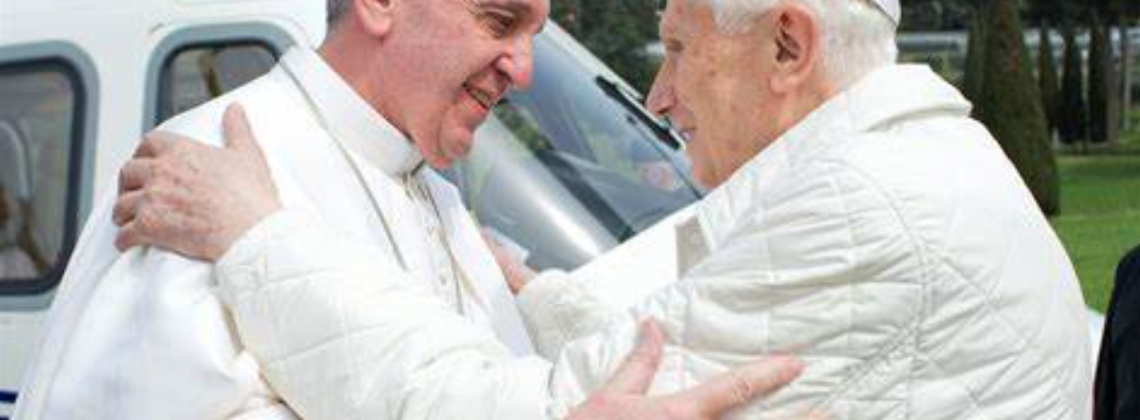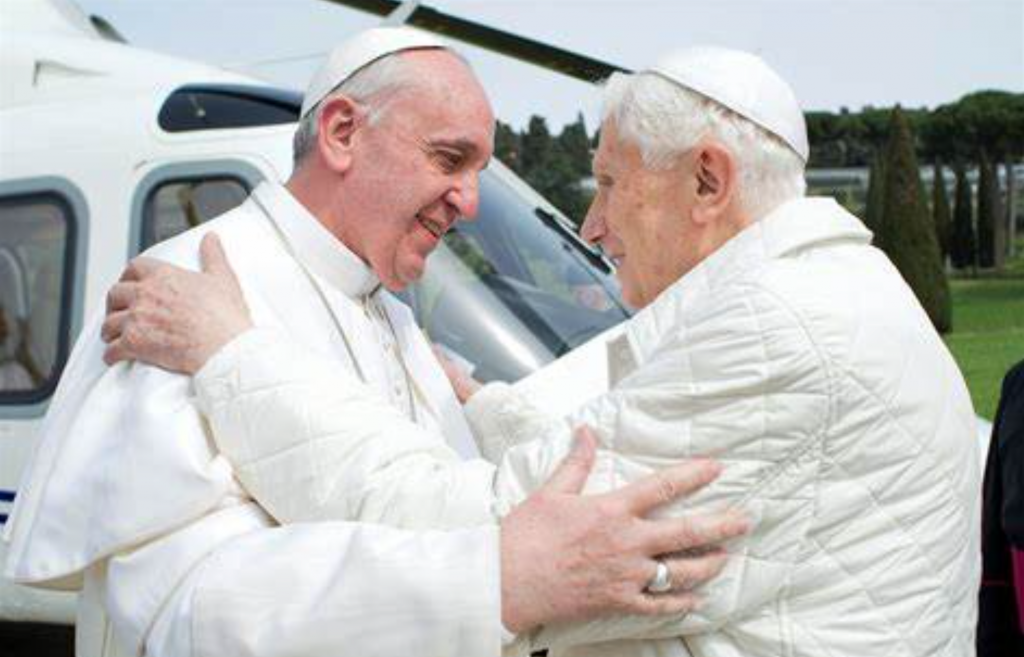

Contrary to his critics’ claims, Benedict embodied the promise of Vatican II
Habemus Papam! We have a pope, one pope, after nine-and-a-half-years of having two popes. The death of “Pope Emeritus” Benedict XVI on December 31, 2022 brought an end to a situation unprecedented in the history of the Roman Catholic Church: the peaceful co-existence of two popes, one retired, one active, neither leveling the charge of “anti-pope” against the other. That the sharp contrast between Benedict and Pope Francis inspired a Netflix movie with an A-list Hollywood cast says something about the continued modern fascination with the papacy, one of the few significant surviving premodern religious institutions. Films abound on the British royal family, but it is hard to imagine anyone producing a film about the Archbishop of Canterbury.
The ”two popes” scenario created by Benedict’s surprise resignation in 2013 may be an appropriate framework for understanding Benedict himself. He was both a man of institutions and a man of ideas. He came to the papacy with the reputation as a fierce “German shepherd”: while Prefect of the Congregation for the Doctrine of the Faith (1981-2005) under John Paul II, he rolled back the tide of liberal theology that flourished in the decade and a half following the Second Vatican Council (1962-1965). The dirty job of silencing heresy obscured a subtle and nuanced theological mind fully engaged with the challenges of modernity and committed to the Second Vatican Council’s vision of speaking to the contemporary world in a contemporary language. The best of the commentary and reflection that has poured out since his death has acknowledged this complexity, this seeming duality; John Allen has called him a “Pope of Ironies.” But most of the commentary has sought instead to situate Benedict in the political categories of the modern West. The strength of Benedict’s career both within the institutional Church and as a modern intellectual lies in his insistence that Christ and his Church have something to offer that transcends the categories offered by the world.
Liberal critics have focused on Benedict as a man of institutions and accuse him of undermining the “renewal” brought about by Vatican II. Benedict no doubt opposed the liberal trajectory of mainstream post-Conciliar theology. But few outside of the inner circle of liberal academic theologians could ever see this trajectory as renewal. Mass attendance dropped dramatically after the initial implementation of liberal reforms in the Church. Much like the architects of the Vietnam War, liberal reformers responded to failure by calling for even more reform; yet endless liturgical experiments and increasing democratization within the Church failed to inspire the return of those lost in the first years following the Council. As head of the Congregation for the Doctrine of the Faith, Benedict did indeed discipline and silence those who challenged orthodoxy on settled matters such as birth control and women’s ordination, and he had no sympathy for consideration of the entirely new issue of gay marriage. For these positions, the liberal Fr. Thomas Reese, S.J., former editor of the Jesuit-run America magazine, judged Benedict to have “done irreparable harm to theological discussion in the church.” Conservative commentators such as Ross Douthat, on the other hand, saw Benedict’s efforts as restoring a measure of “stability and continuity,” righting the ship until the return to liberalism under Pope Francis.
Both of these interpretations of Benedict’s institutional influence are at best half-truths. Benedict did indeed discipline several high-profile dissenting theologians, most notably Charles Curran, the leading critic of Humanae Vitae, Pope Paul VI’s encyclical reaffirming the Church’s traditional opposition to artificial birth control. He later arranged for Fr. Reese’s removal as editor of America for the journal’s persistent attacks on settled Church teaching. Reese’s martyr-posturing aside, Benedict’s actions did little to undermine either the liberal dominance of academic theology or the inertia of liturgical liberalism at the parish level.
This basic sociological reality also works against the conservative narrative of restoration under Benedict (and regression under Francis). As a man of institutions, Benedict did little to move the Church forward toward fulfilling the vision of Vatican II.
As a man of ideas, though, Benedict bequeaths an enduring guide to that future fulfillment. He accomplished this not through his singular genius but by his fidelity to earlier traditions of reform, most especially ressourcement theology and the Liturgical Movement. In different ways, both of these reform movements sought to move the Church away from the defensive and pugnacious approach to modernity associated with the revival of Thomism; rather than refute errors, Christians were to give a positive witness to the beauty and truth of Jesus Christ. To accomplish this task, these traditions turned from medieval scholasticism to the Church Fathers of late antiquity. St. Augustine replaced St. Thomas Aquinas as the central guiding light for this “new” theology.
As an exemplar of these traditions, the German theologian Romano Guardini exerted a profound early influence on the young Joseph Ratzinger. Some of Benedict’s most important writings are rewritings of classic Guardini texts: His 2000 work The Spirit of the Liturgy directly invokes Guardini’s 1918 work of the same title; his three-volume Jesus of Nazareth (2007-2012) updates Guardini’s The Lord (1937). These works show the otherwise theoretical Benedict at his most practical; they are works of spirituality rather than dogmatic theology. Benedict described Jesus of Nazareth as nothing other than his “personal search ‘for the face of the Lord.’” No simple work of piety, the book approaches the face of the Lord via the path of modern biblical scholarship, including the historical-critical tradition and the “search for the historical Jesus.” Benedict affirms that this scholarship has enriched his understanding of the Gospels, and thus of Jesus; he also insists that this scholarship has “proven” very little and failed to achieve the certainty it claimed would follow from an “objective” study of scripture. Benedict’s synthesis of devotional piety and the historical-critical method in Jesus of Nazareth is one of the best examples of the “hermeneutic of continuity” through which he sought to interpret the change called for by the Second Vatican Council.
Benedict published Jesus of Nazareth under his given name, Joseph Ratzinger. He presented this text to the world as a personal spiritual statement, not authoritative Church teaching. At the same time, through his engagement with modern scholarship, he wrote as a public intellectual, addressing skeptical unbelievers as well as the faithful. For readers and writers of Current trying to forge a model of Christian public witness, I can think of no better model than Joseph Ratzinger’s 2005 public debate with the German philosopher and social theorist, Jürgen Habermas, published subsequently as The Dialectics of Secularization: On Reason and Religion (2007). A neo-Marxist of sorts with intellectual roots in the Frankfurt School, Habermas spent much of his career defending Enlightenment reason (in particular, the tradition of Kant) against the onslaught of postmodern irrationality. He and Ratzinger found common ground in affirming the value of reason, though Ratzinger questioned the self-sufficiency of reason, arguing that reason itself needs correction by faith. Habermas conceded much to Ratzinger’s position, though he continued to insist on the self-sufficiency of reason. That this insistence sounds like itself an act of faith seems, at least to this reader, to have proved Ratzinger’s point. That Ratzinger himself never claimed “victory” reflects both his humility and his awareness that there is far more at stake in these debates than simply winning an argument.
Christopher Shannon is associate professor of history at Christendom College in Front Royal, Virginia. He is the author of several works on U.S. cultural history and American Catholic history, including American Pilgrimage: A Historical Journey Through Catholic Life in a New World (2022), available now from Ignatius Press.